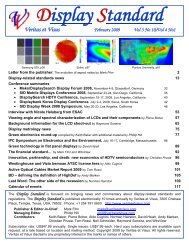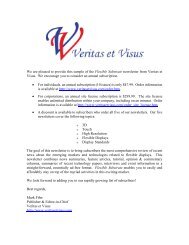Display Standard - Veritas et Visus
Display Standard - Veritas et Visus
Display Standard - Veritas et Visus
Create successful ePaper yourself
Turn your PDF publications into a flip-book with our unique Google optimized e-Paper software.
<strong>Veritas</strong> <strong>et</strong> <strong>Visus</strong> <strong>Display</strong> <strong>Standard</strong> – Special Edition June 2012<br />
Mary Lou Jepson, CEO, Pixel Qi<br />
Mary Lou Jepson was named one of the 100 most influential people in the world by Time<br />
Magazine for her work in creating One Laptop per Child (OLPC) where she led the<br />
engineering, architected the design of the $100 laptop and started the organization (with<br />
Nicholas Negroponte). Wired Magazine credits her laptop architecture design with starting<br />
the low-cost laptop revolution; these low-cost laptops now comprise about 1/4 of the entire<br />
laptop mark<strong>et</strong> just two years after mass production commenced. Mary Lou founded Pixel Qi<br />
Corporation in 2008 in an effort to bring OLPC's display and power management innovations<br />
to the vastly larger commercial mark<strong>et</strong>. Previously, Mary Lou also co-founded Micro<strong>Display</strong><br />
Corp. and served as its CTO for 8 years; served in executive management at Intel<br />
Corporation; and on the faculty at both MIT (Cambridge, MA) and RMIT (Australia). Mary<br />
Lou earned a Ph.D. in Optics, a BSEE and a BA in Art (req.) all from Brown University as well as a MS in<br />
Holography from the MIT Media Lab. She has won numerous awards for her contributions including the 2011<br />
Edwin Land Medal from the Optical Soci<strong>et</strong>y of America, and the 2011 Anita Borg "Women of Vision" Award for<br />
Innovation.<br />
Company Summary: Our team members have been creating advanced display technologies for decades. Pixel Qi<br />
has assembled some of the top display designers in the world. We have come tog<strong>et</strong>her to create innovative display<br />
architectures that can use existing manufacturing lines to allow rapid scale-up and comp<strong>et</strong>itive cost structure. The<br />
screens we have shipped already achieve seemingly impossible performance m<strong>et</strong>rics, including extreme low power<br />
consumption, sunlight readability & low eyestrain. That just scatches the surface of what we can do: we have new<br />
architectures to drive power consumption down 100-fold, embed touch and motion sensing, move to flexible,<br />
bistability, and brighter-than-eink paper like look with full color and video, and create screens that need no cables.<br />
We design all layers of the LCD, including each and every m<strong>et</strong>al and oxide mask, the liquid crystal material and<br />
mode, the optical films, the driving scheme and the backlight structure. Through an innovative approaches we<br />
create screens with new and extraordinary performance.<br />
and...These screens can quickly ramp into high volume mass production quickly with high<br />
yields and excellent cost structure<br />
What do you think is the single most important factor that is currently causing the displays industry to<br />
change? In our vision, new displays, with integrated touchscreens, and wireless capability are the future. <strong>Display</strong>s<br />
on computers should not be just small televisions – although the ability to display HDTV-quality video is essential.<br />
<strong>Display</strong>s for computers need to be optimized to crisply display text, they need to be optimized for a reader just 30<br />
centim<strong>et</strong>ers from the screen; they need to allow for widespread variations in ambient lighting; they need to support<br />
lowering the overall power consumption of the entire device. (Mary Lou Jepson – January 2008)<br />
>>>>>>>>>>>>>>>>>>>>






